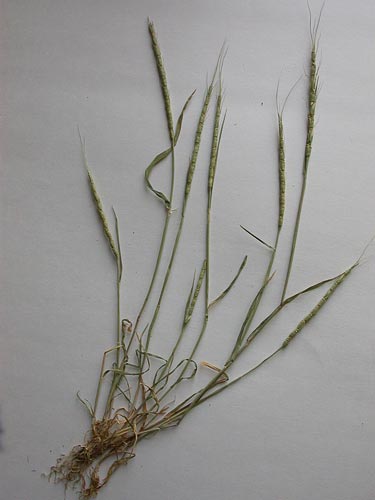Relatives
Aegilops tauschii Coss. - Rough-spiked hardgrass or goatgrass.
Taxonomic position.
Family Poaceae Barnh. genus Aegilops L.Synonyms.
Triticum tauschii (Coss.) Schmalh., T. aegilops P. Beauv. ex Roemer & Schult., Patropyrum tauschii (Coss.) A. Love, Aegilops squarrosa sensu Tausch non L.Morphology and biology.
Annual or biennial plant, 20-40 cm high, with singular or numerous erect or geniculate stems. Leaves are linear. The ear is elongated, cylindrical, sometimes feebly fusiform; in the mature phase glossy, as if polished, with 5-11 spikelets. At the bottom of the ear there is 1 rudimentary or underdeveloped spikelet. The ear is brittle; when mature easily disintegrates into spikelets, especially in the upper part. Spikelets are cylindrical, circular in cross-section; glumes are rectangular-contoured, nearly square-shaped, 5-6 mm in length and 3-4 mm in width, with 7-9 (less frequently 9-11) thin, weakly denticulated veins, becoming almost smooth when the spikelet is mature. In the upper part the glumes are always awnless, truncated, obtuse, with an incrassate edge in a bolster-like fashion, which is more expressed in the lower spikelets. The lemma is 1-2 mm longer than spikelet glumes, narrow-rectangular, with an incrassate upper edge; one corner of the lemma's upper edge is extended into a denticle or a short awn. The length of the lemma's awns ranges from 5 to 36 mm, increasing, as a rule, toward the top of the ear. The awns at the base are grooved. Kernels accrete to paleae.Wind- and self-pollinated plant. Autochore. Propagated by seed. 2n=14.
Distribution.
Crimea (Sudak), Caucasus (all), Middle Asia (river valleys of Syr-Darya and Amu-Darya in their upper and middle course, Kyzyl Kum, northern and western Tien Shan, Gissar-Darvaz, Alai, Tarbagatai, Saur, Dzungarian Ala Tau, Kopet Dagh), Mediterranean region, Asia Minor, Iran, Himalayas.Ecology.
Ephemeron. Winter-hardy. Drought-resistant. Salt-resistant. Grows in semi-deserts, over dry loess or rubbly slopes, gravels, on light sandy or, conversely, heavy clay soils of the plains, sometimes even slightly salinized ones, on seaside sands, dry hills and in weedy places.Utilization and economic value.
Good-quality fodder plant, consumed in spring and early summer. In the flowering phase contains 18.9% of albumens (including 10.7% of protein), 2.1% of fats, 23.0% of cellulose; in the fruiting phase there are 17.1% of albumens (including 11.2% of protein), 5.1% of fats, and 32.4% of cellulose. The D genome, incorporated into tetraploid wheat by the germplasm of Aegilops tauschii, imparted good baking qualities of bread wheat and winter type of vegetation.References:
Boguslavsky, R.L. 1980. Flowering, pollination and spontaneous hybridization in the genus Aegilops L. Synopsis of Ph.D. thesis. Leningrad, VIR, 23 pp. (in Russian).Eig A. 1929. Monographisch-kritische Ubersicht der Gattung Aegilops. Feddes Repertorium Specierum novarum regni vegetabilis Beih, 55:1-228. (in Germany)
Gandilyan, P.A. 1978. Toward the taxonomy of the genus Aegilops L. and the classifier of its species. Biological Journal of Armenia, vol. 31, iss.3, pp. 223-232 (in Russian).
Slageren M. W. van. 1994. Wild wheats: a monograph of Aegilops L. and Amblyopyrum (Jaub. & Spach) Eig (Poaceae). Wageningen Agriculture University Papers 1994 (7). 513 pp.
Sorokina, O.N. 1928. Concerning chromoses in gen. Aegilops L.Works on Applied Botany, Genetics and Plant Breeding, series 2, pp. 524-529 (in Russian).
Tsvelev, N.N. 1976. Cereal grasses of the USSR. Leningrad, Nauka, 788 pp. (in Russian).
Zhukovsky, P.M. 1928. Critique and taxonomic survey of Aegilops L. species. Works on Applied Botany, Genetics and Plant Breeding, vol.18, iss.1, pp. 417-609 (in Russian).


